This article has been updated to reflect the 2022-2026 DP Code of Points.
Level 10 bars… this is some of the greatest stuff out there. There’s nothing else I’d rather be judging (or even just watching!). It’s funny because I never loved bars as a gymnast. I was tall, it was hard, and I much preferred to flip on floor or vault. But now, I love the intricacy and skill of a great Level 10 bar routine.
What makes a bar routine great? Let’s dive into the specifics of a Level 10 bar routine.
Overview of Level 10 Bars
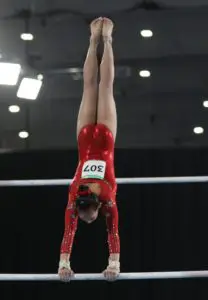
First, let’s go over the basics. Level 10 is an advanced optional level. In each optional level, gymnasts must perform a set number of skills with different values (Value Parts) as well as skills from specific categories (Special Requirements).
In level 10, routines do not start from a 10.0, and the gymnast needs to earn bonus points to get to the 10.0 Start Value. If all Value Parts and Special Requirements are fulfilled, the maximum score is 9.5. A maximum of 0.50 in bonus can be earned, which will bring the Start Value up to a 10.0. In Level 10, bonus points can be earned for D and E skills, as well as for combinations of difficult skills.
Execution and amplitude deductions are taken throughout the routine, with an emphasis on clean form and handstand positions throughout.
After the routine is complete, the judges will evaluate the difficulty of the skills performed, and additional deductions can be taken if the routine does not meet certain criteria. We’ll talk more about that later.
Value Parts in a Level 10 Bar Routine
Just like Level 8 and Level 9, each Level 10 bar routine has a certain number of skills required at different values. For maximum value at Level 10, gymnasts need at least 3 A’s, 3 B’s, and 2 C’s in their routine. Most times, if the Special Requirements are met, these Value Parts will also be met. However, it’s always good to count them up just to be sure. A’s are worth 0.10, B’s are worth 0.30, and C’s are worth 0.50. More difficult skills can replace easier Value Parts, but not the other way around.
Skills can receive Value Part credit two times, as long as they are performed in a different connection. This means that there must be a different skill performed either before or after it. If a skill is performed a third time, it will not receive Value Part credit, and it is not eligible to fulfill Special Requirements.
In a Level 10 routine, there are no difficulty restrictions. Level 10 gymnasts can perform as many D and E elements as they like! A Level 10 gymnast will need to perform at least 1 D level skill in order to start from a 10.0.
Special Requirements for a Level 10 Bar Routine
There are four special Requirements for a Level 10 bar routine. In order to receive the maximum Start Value, the gymnast must complete all four Special Requirements. The Level 10 Special Requirements are:
- One Flight Element (min. C)
- 2nd, Different Flight Element (min. B)
- Element with LA Turn (min. C)
- C salto Dismount
Flight Element (Min. C)
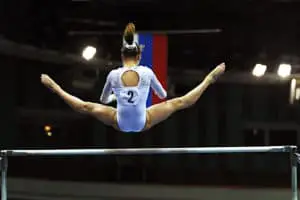
A flight element, or release, is a skill in which the hands release and regrasp the bar. Flight elements can be performed on the same bar, or they can be used as transitions from one bar to the other. In Level 10, it’s common to see both types of flight elements in a routine.
This is a part of the Level 10 routine in which gymnasts can really showcase their specific strengths. There is an almost endless supply of release moves, from all different categories. It’s fun to play around and see what naturally suits each gymnast! And don’t be afraid to try something different – judges LOVE seeing new and cool skills. You might need to keep your Code handy at meets though – some judges may not recognize that cool, unusual skill you’ve been working so hard to perfect.
Here are some examples of each type of release, although these lists are certainly not all-inclusive.
Examples of low-high releases:
- Toe hecht (C)
- Shaposhnikova/Maloney (D)
- Khorkina (Shaposh-1/2) (E)
Examples of high-low releases:
- Straddle back to support (B)
- Bail to support from support (B)
- Straddle back to support from handstand (C)
- Straddle back to handstand (C) – if it comes from HS, it’s a D
- Peach (C)
- Bail to support from handstand (C)
- Bail to handstand (D)
- Pak salto (D)
- Ezhova (D)
Examples of same-bar releases:
- Cast handstand-hop to reverse grip (C)
- Giant-hop to reverse grip (C)
- Jaeger (D)
- Gienger (D)
- Tkatchev (D)
- Deltchev (D)
- Piked Jaeger (E)
- Ray (E)
2nd Flight Element (Min. B)
For this requirement, the gymnast must perform a second, different, flight element, minimum B value. She can choose from the lists above, or find another preferred release from the Code. Do you have a favorite that isn’t listed above? Drop it in the comments!
Element with LA Turn (Min. C)
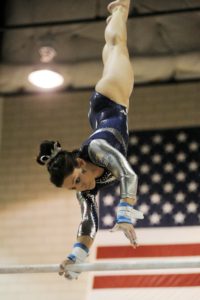
An element with LA turn is the next requirement for Level 10 bars. This element can be a pirouetting element or a flight element, but it cannot be a mount or a dismount.
One skill can count for the LA turn as well as one of the flight elements. An example of a skill that would count for both requirements is a bail.
Examples of LA turns:
- Bail from handstand to support (C)
- Cast handstand ½ pirouette (also blind change, Higgins, or Healy) (C)
- Clear hip ½ pirouette, Stalder ½ pirouette, or sole circle ½ pirouette (C – to regular or mixed grip, D – to reverse, L, or mixed L grip)
- Giant ½ turn – (C – any technique)
- Front giant ½ turn or Healy (C)
- Uprise to handstand ½ pirouette (C)
- Giant full (D)
- Giant 1 ½ (D)
- Bail to handstand (D)
- Gienger (D)
- Pak 1/1 (E)
- Khorkina (E)
- Hop-full (E)
C dismount
A gymnast must perform a dismount of at least C value to fulfill this requirement.
Here are some examples of C dismounts:
- Double tuck flyaway
- Double pike flyaway
- Comaneci salto
- Toe-on front (tucked, piked, or with ½ twist)
- Flyaway with 1 ½ or 2/1 twist
- Front flyaway with 1 ½ or 2/1 twist
- Facing LB – cast to near handstand, front pike salto dismount
- Facing LB – cast to near handstand, back tuck or pike salto dismount
- Facing LB – Clear hip circle to back tuck or pike salto dismount
- Facing LB – Giant circle to back tuck salto dismount (Gonzales)
Here are some examples of D/E dismounts:
- Flyaway with 2 ½ twist (D)
- Layout/pike double flyaway (D)
- Double layout (E)
- Fontaine (Arabian double front) (E)
- Full twisting double back (any type) (E)
- Double front (E)
Bonus Opportunities
At Level 10, gymnasts must earn a total of 0.50 in bonus points to start from a 10.0. They can earn up to 0.40 in Connection Value (CV), for difficult skills connected together, and they can earn up to 0.40 in Difficulty Value (DV) for D or E skills within the routine. A gymnast can NOT earn all 0.50 in one category (CV or DV). Just like Level 9, bonus is not awarded if a fall or spot occurs during the skill.
Connective Value
Connective Value (CV) in Level 10 bars is different, and more difficult, than in Level 9 bars. Here are the ways to earn CV in a Level 10 bar routine:
- C+C (both elements with turn and flight): +0.10
- C+D (no turn or flight necessary in either element): +0.10
- D+D or more difficult (no turn or flight necessary in either element): +0.20
The dismount will count as a flight element for C+C bonus connections.
Difficulty Value
D elements receive +0.10 in DV, and E elements receive +0.20 in DV. If a gymnast performs a D or E element twice in her routine, she will receive Value Part credit for it twice, but she can only receive DV for it once.
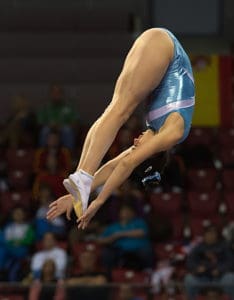
How to Get a 10.0 +1 Start Value
In Level 10, on bars, beam, and floor, gymnasts have the opportunity to earn a 10.0 +1 Start Value. The Start Value should be flashed as 10.0 +1 if the gymnast achieves it.
In order to achieve a 10.0 +1 for a Level 10 bar routine, the gymnast must have a 10.0 Start Value, at least 0.60 in bonus, and an E skill within the routine or as a dismount. The E skill may not have a fall or spot.
I’ve seen it happen before where a gymnast had 0.60 in D/E bonus, including at least one E, but did not have any CV in her routine. Without at least 0.10 CV, the routine does not start from a 10.0. So if you have an E skill, make sure to get your CV in so you can get your 10.0 +1!
Composition Deductions for a Level 10 Bar Routine
Composition deductions are taken after a routine is over, as the judge reviews the types of skills performed in the routine. The Special Requirements demonstrate the bare minimum skill level that is required for a Level 10 bar routine. However, to minimize composition deductions, the routine must meet certain higher standards.
There are several categories of composition deductions for a Level 10 bar routine. Here’s a breakdown of these categories, and what’s required for no deductions.
Releases Not Up to the Level
The minimum level of release skills to meet the Special Requirement is one C and one B release. However, the requirement for no composition deduction is more stringent. To receive no deduction, the gymnast must perform two different D or E releases. The C and B release that meet the Special Requirement will receive a 0.20 composition deduction.
Here are the specifics of the composition deductions for release level:
- D/E, D/E (different, not required to be connected)
NO deduction - D/E+C (directly connected)
0.05 deduction - D/E, C (isolated, not connected)
0.10 deduction - C+C (directly connected)
0.15 deduction - D/E, B (isolated, not connected)
0.15 deduction - C, C (isolated, not connected)
0.20 deduction - C, B or less
0.20 deduction
Dismount Not Up to the Level
The expected level of dismount for no deduction is a D or E dismount, or D/E+C directly connected. A common D+C dismount is giant-full to double flyaway, but there are many combinations that could be performed!
Here are some examples of potential dismounts, and the deductions for dismount level:
- Double layout dismount (E)
NO deduction - 2 ½ twist dismount (D)
NO deduction - Stalder-full, double pike dismount (D+C direct)
NO deduction - Giant ½, Front giant ½, Double flyaway (C+C+C)
0.05 deduction - Giant full, Clear hip handstand, Double full dismount (D+C+C)
0.05 deduction - Giant ½ (blind), front layout 1 ½ twist dismount (C+C)
0.10 deduction - Toe-on front tuck (Isolated C)
0.10 deduction
Choice of Elements
Choice of elements: Failure to perform elements that meet 2 of the following 3 categories:
- Forward element, minimum B
- 2. Group 3/6/7 element, minimum B
- 3. Element with LA turn, minimum C
Deductions for the choice category:
- 2/3 categories performed – NO deduction
- 1/3 categories performed – 0.10 deduction
- 0/3 categories performed – 0.20 deduction
Other Composition Deductions
Here are the rest of the composition deductions for Level 10 bars:
- Uncharacteristic element – 0.10 each time
- Squat on low bar, ½ turn to grasp high bar
- Swing forward from high bar, place feet on low bar (with or without ½ turn)
- Climbing onto low bar within the routine
- ¾ Giant Forward, with or without grip change – 0.10 each time
- Lack of direction change during routine – 0.10
- Mount and dismount do not count
- 1/1 turn does not count
- More than one squat/stoop on low bar – 0.10 (Exception – if the gymnasts falls, she is allowed to perform an additional squat/stoop on to resume her routine)
- Lack of two bar changes – 0.20
Final Thoughts
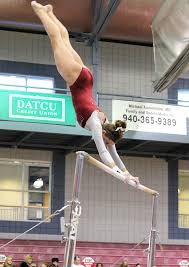
Level 10 bars is a fun and exciting level, with many options available to fulfill the requirements. If you’ve got a great swinger, it might not be too hard to construct a routine. However, for a gymnast who doesn’t have multiple D or E skills under her belt, that task becomes much tougher.
For any gymnast, consider how her best skills can be combined to maximize Special Requirements, bonus, and composition. For instance, if she can combine two D’s, she’s already got 0.40 in bonus. Add a difficult dismount or dismount combo, and you’ll be well on the way to a high Start Value.
If the big skills aren’t quite competition ready yet, don’t worry! Pick clean skills that fulfill the requirements, and gradually build as you’re able to. A clean, easier routine often scores higher than a difficult routine with mistakes or form breaks.
Further Reading
The Ideal Composition for a Level 8 Bar Routine
The Ideal Composition for a Level 9 Bar Routine
The Ultimate Guide to Gymnastics Grips
Making Sense of Composition: Level 10 Beam
Making Sense of Composition: Level 10 Floor
References
USA Gymnastics J.O. Code of Points, 2022-2026.
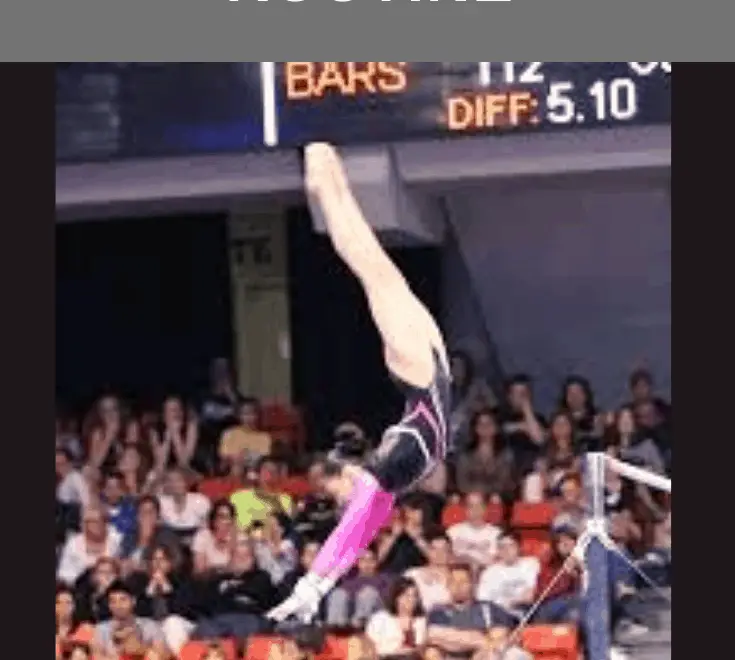
face mask says:
You can create interest in any topic! Bravo!